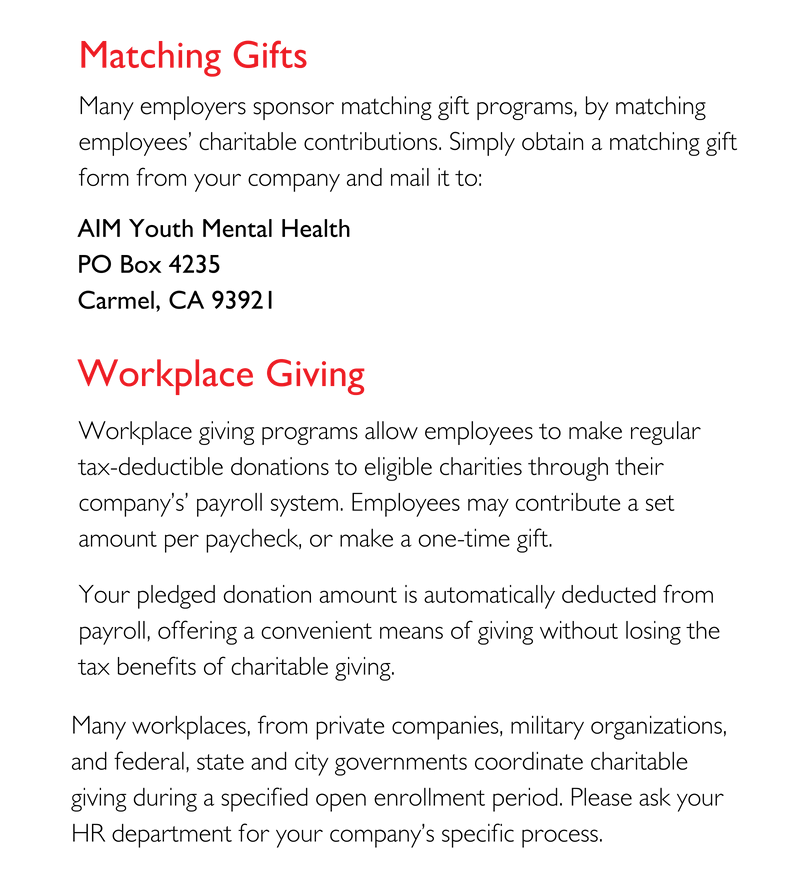
 By Meadowlark Monaghan, AIM Youth Advisory Board Member
By Meadowlark Monaghan, AIM Youth Advisory Board Member
ADHD, Attention-Deficit/Hyperactivity Disorder, is an experience that affects many young people—around 5-7% of youth, worldwise. Rates of diagnosis are higher in the U.S., perhaps because of strong achievement pressures and all-too-often, quick diagnoses.
While each child with ADHD will have a unique experience, there is common ground with the kinds of challenges they may face and possible solutions that may help support them. It’s important to note that even amongst “youth”, ADHD displays differently from childhood into teenage years. ADHD can be a seriously debilitating challenge and a manageable condition. The breadth of experience is as wide as any other mental health challenge and each child deserves a care plan as unique as their experience.
This toolkit will begin to cover some of that common ground to give you a jumping off point into the collective ADHD experience of youth and teens.
What is ADHD?
ADHD is a neurodevelopmental condition that affects how you think, focus, and control your impulses. While everyone has moments of inattention and hyperactivity, individuals with ADHD experience these challenges more intensely and consistently.
ADHD can be divided into three main types:
- Inattentive type: People with this type of ADHD have trouble paying attention, staying organized, and completing tasks.
- Hyperactive-impulsive type: This type is characterized by excessive fidgeting, restlessness, and impulsive behavior.
- Combined type: This is a combination of inattentive and hyperactive-impulsive symptoms.
ADHD symptoms can change over time as a child grows into their preteen and teenage years. It’s estimated that about a third of children diagnosed with ADHD no longer meet criteria by young adulthood. At the same time, the vast majority continue to have impairing symptoms periodically–often depending on the supports they have. For those who do, symptoms may morph with their changing responsibilities and environment.
Younger children typically experience more hyperactivity and impulsivity, things like getting up to move around in class and having a hard time waiting to react or speak in turn. As they grow up, academic and social demands increase, morphing symptoms into displaying less hyperactivity and more inattention.
Throughout adolescence, as structure and supervision begin to decrease, demands and expectations begin to increase. This contributes to challenges with academic performance and interpersonal problems. In addition to increased inattention and impulsivity, teens with ADHD may also engage in impulsive and risky behaviors—such as: substance use, unsafe sexual activity, and self harm.
On average, girls with ADHD are more likely than boys with ADHD to show the exclusively inattentive type (or, as it’s now termed, ‘presentation’). But girls (and women) may also show subtle forms of impulsive behavior, including interrupting others and poor planning.
Without support, youth and teens with ADHD can experience lower grade averages, poorer emotion-regulation, higher rates of suspension for problematic behavior, serious problems with peer relationships (some research points to fewer reciprocal friends), higher rates of bullying, higher rates of driving accidents, and more. Tragically, self-harm is elevated in youth with ADHD as they get older, as well.
Etiology
While the exact cause of ADHD is not fully understood, there are some factors that may contribute to its development.
These include:
- Genetics: ADHD often runs in families; twin and adoption studies reveal a strong genetic vulnerability. In many cases, both parents and child share ADHD symptoms, within biological families. Realizing that genes and biology are important may alleviate guilt and blame–but families are still responsible for securing evidence-based treatment.
- Brain structure and function: Research has shown that children with ADHD can have slightly smaller brain regions (including many regions that impact executive functioning). While those continue to mature and become a less significant difference by adulthood, there are still differences in brains with ADHD in activity, connectivity, and neurochemistry.
- Environmental factors: There are certain environmental factors that have been labeled as risk factors to developing ADHD. Prenatal exposure to smoking, alcohol, or lead, nutritional factors, as well as lifestyle/psychosocial factors, may increase the chance of ADHD developing.
ADHD Symptoms
Recognizing the symptoms of ADHD is the first step in understanding how best to support someone with ADHD.
An ADHD experience can look like:
Inattention:
- Difficulty staying focused on tasks, especially boring or daily, repetitive everyday things (school work, chores, etc.)
- Forgetfulness in daily activities
- Constantly misplacing or losing personal items
- Missing appointments or being late frequently
- Trouble following instructions or completing homework
- Being bored a lot
- Poor organization and planning skills
- Doesn’t seem to listen when spoken to directly
- Procrastination
- Tendency to wait to the last minute
- Trouble following directions
- Feeling like they aren’t near or reaching their potential
Hyperactivity:
- Excessive talking and restlessness
- Being fidgety
- Easily agitated
- Difficulty remaining seated or quiet when required
- Impulsivity, such as acting before thinking about the consequences
- Getting up frequently to walk around
- Trouble playing quietly
Impulsivity:
- Impatience
- Having a hard time waiting to talk or react
- Blurting out answers before someone is finished asking a question
Coping Strategies for ADHD
If you or your child has ADHD, there are many coping strategies that can help support you. These are research-backed and work well for anyone’s mental wellness, across a myriad of diagnoses (or lack thereof). It’s important to note that not every coping strategy will work for every person. It’s important to find routines and skills that work best for you or your child, and remain open-minded to adapting those routines over time.
Some examples of classic coping strategies include:
- Medication: Some individuals with ADHD benefit from medication prescribed by a healthcare professional, such as stimulants or non-stimulants. These can help improve focus and reduce impulsivity.
- Cognitive-behavioral therapy (CBT): CBT can teach you skills to better manage your thoughts and behaviors, helping you become more organized and efficient. For children with ADHD, CBT works best in the form of reward-based programs conducted by families and schools (more behavioral than cognitive).
- Time management: Tools like planners and alarms to keep track of tasks and appointments. Breaking tasks into smaller, manageable parts, and prioritizing them can also be helpful.
- Healthy lifestyle: Regular exercise, a balanced diet, and sufficient sleep can have a positive impact on ADHD symptoms.
- Support systems: Seek support from parents, teachers, counselors, or support groups—individuals can provide guidance and understanding.
- Mindfulness and relaxation techniques: Practices like meditation and deep breathing can help to calm the mind and reduce impulsivity.
- Learning tools: Utilizing technology and apps designed for individuals with ADHD can help with time management, organization, and focus. But an over-reliance on screens is not a good idea.
Strategies for Parents
Since ADHD has a strong genetic component, if your child has ADHD, it may be worth noting that you may also experience adult ADHD. By empowering your understanding of your own brain, you may be presented with greater opportunities to connect and relate to your child’s experiences as well. Despite a diagnosis for yourself, there are some strategies you can implement to best support a child with ADHD.
Helpful things to do if you have a child with ADHD includes:
- Identify your child’s strengths and support them! Give praise and rewards to enforce good behavior. Criticism and punishment can tank self-esteem.
- Give breaks throughout the day
- Keep it short and sweet. Give clear, short directions to prevent them from getting overwhelmed or forgetting multiple steps
- Use timers + reminders to help your child shift from one task to the next
- Learn more about ADHD to help them understand their unique brain! Read, talk with a provider, watch videos together, etc.
- Be consistent with rules and consequences. Consequences aren’t always negative and can include incentives.
- Use touch and affection to communicate effectively (i.e. a hand on their arm or around their shoulder, look in their eyes, etc). Be mindful of using touch with kids with sensory issues or trauma.
While ADHD may have flooded our algorithms and classrooms, it’s important to know that having ADHD reveals a difference in brain function and self-regulation, not an inherent flaw. Each one of our unique brains deserve the learning techniques and structural support that best serves them.
______________________
About the Author
Meadowlark Monaghan (she/hers) is a consultant using her knowledge gained as a mental health professional to act as a liaison between brands, creators, + online communities with the field of psychology and mental health. She also co-hosts the personal development podcast, Thoughts May Vary. Her work has been seen with Madhappy, Local Optimist, The Mayfair Group, Lonely Ghost, AIM Youth Mental Health, NAMI San Diego and more.


















 Moving Upstream: A Proactive Approach to Addressing Behaviors and Bullying
Moving Upstream: A Proactive Approach to Addressing Behaviors and Bullying Krista Reuther is the Assistant Director of Ohana’s Community Health and Prevention Program. She received her Masters in Public Health and Social Work at UC Berkeley. She comes to this position after 14 years of clinical social work experience at Stanford Children’s Hospital in pediatric oncology, critical care, and bereavement. Her goal is to reduce the incidence of mental illness in children and adolescents in Monterey County.
Krista Reuther is the Assistant Director of Ohana’s Community Health and Prevention Program. She received her Masters in Public Health and Social Work at UC Berkeley. She comes to this position after 14 years of clinical social work experience at Stanford Children’s Hospital in pediatric oncology, critical care, and bereavement. Her goal is to reduce the incidence of mental illness in children and adolescents in Monterey County. Dr. Guss is a 35-year veteran educator with a doctorate degree in Educational Leadership. She served as a classroom teacher for 10 years, including two years as a teacher in a bilingual program in South Central Los Angeles. She has also served as a college professor, mentor teacher for new teachers, and a master teacher for teacher candidates completing their student teaching experience. She continues to be a strong advocate for the teaching profession.
Dr. Guss is a 35-year veteran educator with a doctorate degree in Educational Leadership. She served as a classroom teacher for 10 years, including two years as a teacher in a bilingual program in South Central Los Angeles. She has also served as a college professor, mentor teacher for new teachers, and a master teacher for teacher candidates completing their student teaching experience. She continues to be a strong advocate for the teaching profession. Fellowship: Stanford University School of Medicine (1994) CA
Fellowship: Stanford University School of Medicine (1994) CA Michael G. Thompson, Ph.D. is a consultant, author and psychologist specializing in children and families. He is the supervising psychologist for the Belmont Hill School and has worked in more than seven hundred schools across the United States, as well as in international schools in Central America, Europe, Africa and Asia.
Michael G. Thompson, Ph.D. is a consultant, author and psychologist specializing in children and families. He is the supervising psychologist for the Belmont Hill School and has worked in more than seven hundred schools across the United States, as well as in international schools in Central America, Europe, Africa and Asia.
 is 15 years old and a sophomore at Marina High School in Marina, CA. Her academic interests include math, history, and psychology. She joined the AIM Ideas Lab in 2021 because she wanted to be a part of something that could have a great impact on her community. Marwa is interested in youth mental health because she has always been fascinated with the human mind and she wants to support those that are suffering who may feel like their challenges in life aren’t important enough or are too afraid to seek necessary help.
is 15 years old and a sophomore at Marina High School in Marina, CA. Her academic interests include math, history, and psychology. She joined the AIM Ideas Lab in 2021 because she wanted to be a part of something that could have a great impact on her community. Marwa is interested in youth mental health because she has always been fascinated with the human mind and she wants to support those that are suffering who may feel like their challenges in life aren’t important enough or are too afraid to seek necessary help. Giovanna Panetta is a 16 year old junior at Carmel High School. She has always been called to STEM subjects, specifically biology. The AIM Ideas Lab instantly attracted her attention as a research opportunity. Gia has always comprehended the importance of mental health. She knows that COVID only exacerbated previously existing problems, and that as a community we can try and find the root of those problems. Mental health is an integral part of life, and can impede a body’s ability to be healthy. She strongly believes that life is worth living, and she wants to help anyone that thinks otherwise.
Giovanna Panetta is a 16 year old junior at Carmel High School. She has always been called to STEM subjects, specifically biology. The AIM Ideas Lab instantly attracted her attention as a research opportunity. Gia has always comprehended the importance of mental health. She knows that COVID only exacerbated previously existing problems, and that as a community we can try and find the root of those problems. Mental health is an integral part of life, and can impede a body’s ability to be healthy. She strongly believes that life is worth living, and she wants to help anyone that thinks otherwise. Dr. Friedman completed her undergraduate degree in Psychology from University of California San Diego (UCSD). She went on to complete her masters and doctorate degrees (Ph.D.) in Clinical Psychology from Rosalind Franklin University of Medicine and Science/Chicago Medical School. Dr. Friedman completed her pre-doctoral internship at Rush University Medical Center, Chicago, IL, and her post-doctoral fellowship training at the VA San Diego Healthcare System. Her clinical training and experience has been focused primarily on comprehensive assessment and effective treatments for anxiety, mood and related disorders. Dr. Friedman has extensive experience in providing Cognitive Behavioral Therapies for anxiety disorders (e.g. worry, OCD, social anxiety, phobias and PTSD), depression, adjustment disorders/life stress, insomnia and body-focused repetitive behaviors (e.g. Trichotillomania and skin picking). She has received training in evidence-based interventions for a variety of specific problems, including exposure with response prevention (ERP) for treatment of OCD, Prolonged Exposure (PE) for treatment of PTSD, and Cognitive Behavioral Therapy for Insomnia (CBT-I). Moreover, she has specialty training in the treatment of childhood anxiety and related disorders, such as ADHD, selective mutism, separation anxiety, PTSD, depression and specific phobias. In addition, Dr. Friedman has developed an expertise in research on Trichotillomania and body-focused repetitive behaviors, which has led to numerous local and national presentations. Dr. Friedman regularly attends local and national conferences, training seminars and workshops in order to stay informed on the most up to date treatments and apply state of the art science into her clinical practice.
Dr. Friedman completed her undergraduate degree in Psychology from University of California San Diego (UCSD). She went on to complete her masters and doctorate degrees (Ph.D.) in Clinical Psychology from Rosalind Franklin University of Medicine and Science/Chicago Medical School. Dr. Friedman completed her pre-doctoral internship at Rush University Medical Center, Chicago, IL, and her post-doctoral fellowship training at the VA San Diego Healthcare System. Her clinical training and experience has been focused primarily on comprehensive assessment and effective treatments for anxiety, mood and related disorders. Dr. Friedman has extensive experience in providing Cognitive Behavioral Therapies for anxiety disorders (e.g. worry, OCD, social anxiety, phobias and PTSD), depression, adjustment disorders/life stress, insomnia and body-focused repetitive behaviors (e.g. Trichotillomania and skin picking). She has received training in evidence-based interventions for a variety of specific problems, including exposure with response prevention (ERP) for treatment of OCD, Prolonged Exposure (PE) for treatment of PTSD, and Cognitive Behavioral Therapy for Insomnia (CBT-I). Moreover, she has specialty training in the treatment of childhood anxiety and related disorders, such as ADHD, selective mutism, separation anxiety, PTSD, depression and specific phobias. In addition, Dr. Friedman has developed an expertise in research on Trichotillomania and body-focused repetitive behaviors, which has led to numerous local and national presentations. Dr. Friedman regularly attends local and national conferences, training seminars and workshops in order to stay informed on the most up to date treatments and apply state of the art science into her clinical practice. Dr. Piacentini is a board-certified clinical child and adolescent psychologist and Professor in the UCLA Department of Psychiatry and Biobehavioral Sciences. He directs the UCLA Child OCD, Anxiety, and Tic Disorders Clinic and Tourette Association Center of Excellence which provide diagnostic evaluation and treatment (both therapy and medication) for youth with the above problems. He also directs the UCLA Center for Child Anxiety Resilence, Education, and Support (CARES; carescenter.ucla.edu) which provides education and programming to parents, teachers, and clinicians about anxiety prevention and management.
Dr. Piacentini is a board-certified clinical child and adolescent psychologist and Professor in the UCLA Department of Psychiatry and Biobehavioral Sciences. He directs the UCLA Child OCD, Anxiety, and Tic Disorders Clinic and Tourette Association Center of Excellence which provide diagnostic evaluation and treatment (both therapy and medication) for youth with the above problems. He also directs the UCLA Center for Child Anxiety Resilence, Education, and Support (CARES; carescenter.ucla.edu) which provides education and programming to parents, teachers, and clinicians about anxiety prevention and management. Citlalli Nava is 18 years old and a first year majoring in Psychology at Hartnell Community College in Salinas, CA. She is passionate about understanding how mental health affects how youth think, act, and feel. Citlalli joined the AIM Ideas Lab in 2021 after witnessing the increase in mental health challenges in teenagers and considering the mental health issues they are facing. Citlalli is interested in youth mental health because it is a real problem faced by her generation.
Citlalli Nava is 18 years old and a first year majoring in Psychology at Hartnell Community College in Salinas, CA. She is passionate about understanding how mental health affects how youth think, act, and feel. Citlalli joined the AIM Ideas Lab in 2021 after witnessing the increase in mental health challenges in teenagers and considering the mental health issues they are facing. Citlalli is interested in youth mental health because it is a real problem faced by her generation. Clinical and community psychologist and health care innovator Arthur C. Evans Jr., PhD, is CEO of the American Psychological Association, the leading scientific and professional organization representing psychology in the United States. With more than 146,000 researchers, educators, clinicians, consultants, and students as members, APA promotes and disseminates psychological knowledge to benefit society and improve lives – a mission consistent with Evans’ life work.
Clinical and community psychologist and health care innovator Arthur C. Evans Jr., PhD, is CEO of the American Psychological Association, the leading scientific and professional organization representing psychology in the United States. With more than 146,000 researchers, educators, clinicians, consultants, and students as members, APA promotes and disseminates psychological knowledge to benefit society and improve lives – a mission consistent with Evans’ life work.


